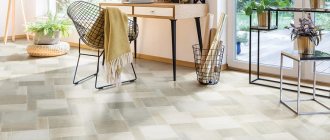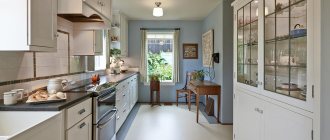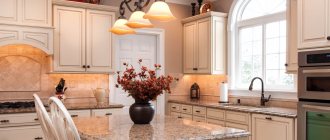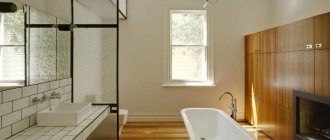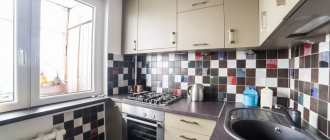If you think that linoleum in the kitchen is temporary and frivolous, then get ready for a serious alteration of your picture of the world. This material has long since firmly moved from the category of budget flooring options to a much more presentable segment and sometimes completely outshines ceramic tiles and laminate in terms of expressiveness—and practicality at the same time. But in order to successfully choose linoleum for the kitchen, you first need to thoroughly understand its types and characteristics: here and now we are conducting a narrowly focused educational program with a large number of photos of real interiors for clarity.
Advantages and disadvantages
«+»:
- soft and elastic coating that is difficult to damage by a dropped plate or any other object;
- does not attract dust and is very easy to clean, while the likelihood of fungal structures or mold appearing is close to minimal;
- has excellent thermal insulation and does not cool, creating comfort at any time of the year, even in frosty winter;
- remains virtually silent under any influence on it;
- low price even for the best options;
- excellent wear resistance - up to 15 years;
- “friendly” with abrasive detergents.
«-«:
- softness leads to pressing in places where heavy furniture stood, which seriously limits your manipulations during rearrangement;
- the seams are clearly visible, indicating the junction of one fragment with another - this spoils the appearance a little;
- even the most reliable type of linoleum can lose its color over time;
- in some cases, an unpleasant odor is observed, which goes away over time;
- It is easy to cut and scratch, so it is inferior in reliability to alternative options (the same tile or laminate).
For example, this is what happens to linoleum if you move furniture too carelessly (in this case, a refrigerator).
Features and purpose of the material
Linoleum was created as a coating that is resistant to the main problems of the kitchen space. The list of requirements that it must meet is quite wide:
- Hygiene – for the ability to carry out wet cleaning daily;
- Slight roughness - on a perfectly smooth floor - both wet and dry - it is easy to slip and get injured;
- Durability - loads in the form of sliding chair legs, moving objects and furniture on its surface should not lead to rapid abrasion;
- Tensile strength – falling of utensils, including sharp knives, from the table or from the hands of family members is quite common. High-quality material retains its integrity for many years due to its moderate stretchability;
- Minimal hygroscopicity - linoleum on the kitchen floor should dry quickly and not absorb the components of chemical detergents;
- Immunity to microorganisms - low quality linoleum can become a breeding ground for pathogenic bacteria;
- Lack of toxicity - the first sign of the presence of toxic fumes is a pungent heavy odor that does not disappear within 24 hours.
A quality that is rarely considered important is the release form, that is, the width of the roll: the fewer joints there are between the sheets, the lower the likelihood of deformation and the formation of contaminated cracks. It is also important that the material has sufficient fire resistance, thermal and sound insulation.
Types of linoleum
It is easy for anyone to get confused in the classification of material. Let's try to understand all types of linoleum in order to choose the best option for the kitchen.
By material
If we take as a basis the characteristics of basic materials, we can highlight:
- natural - lime or cork conglomerate is applied to jute or flax fiber;
- artificial - made of PVC or rubber.
The first option is very expensive, but environmentally friendly and is recommended for finishing floors in children's rooms. But linoleum made from artificial materials is widespread because it gives the best quality for the price.
By the number of layers in the canvas
- homogeneous - single-layer, completely homogeneous in structure, most often used in public spaces with high traffic;
- heterogeneous - a two-layer or multi-layer structure, widely used for finishing floors in modern apartments and houses.
By purpose
But here the thickness of the layer plays a role - this directly affects the service life and abrasion class:
- commercial - has a single-layer structure 0.7 cm thick, made of PVC, intended for use in public buildings, service life - up to 45 years;
- semi-commercial - felt is added to the composition, which significantly improves the thermal insulation qualities of the material, thickness - 0.5 cm, service life - up to 12 years;
- household - on a foamed felt base, the most versatile and aesthetically pleasing type, recommended for use at home.
Varieties
There are different types of linoleum for the kitchen, which differ in resistance to abrasion, thickness and the presence or absence of a protective layer into three types:
- domestic;
- semi-commercial;
- commercial.
Household linoleum is distinguished by its affordable cost, variety of colors and rather low wear resistance. It may have a felt or polyurethane base.
Semi-commercial flooring is characterized by high wear resistance and the ability to retain heat well due to the presence of a felt and synthetic base.
Commercial linoleum is considered the most durable and durable. It is made from PVC. It does not have an additional substrate, and its structure has a homogeneous structure, thanks to which, even with prolonged use of such a floor, its pattern, imprinted to the full depth, does not wear out.
Expert advice will help you understand which linoleum is best suited for the kitchen. Commercial flooring will last a long time, as it is highly resistant to abrasion, which ensures the presence of a protective layer and a homogeneous structure. It does not absorb moisture, is fire-resistant and provides the hygienic conditions required for the kitchen.
Based on the type of material, such flooring is divided into natural and artificial. Natural linoleum is expensive, as it is produced on the basis of natural materials:
- jute fiber;
- flax fiber;
- pressed cork;
- limestone conglomerate.
Such material is expensive, like any type of environmental finishing. Natural linoleum is distinguished by:
- good wear resistance;
- moisture resistance;
- long service life 25-45 years;
- ability to withstand exposure to chemicals, ultraviolet radiation, detergents, moisture;
- resistance to mold and fungi due to natural impregnation with linseed oil, which has good bactericidal properties;
- ability to retain heat well;
- ability to repel various types of pollution.
If your budget allows, natural marmolium can be laid in the kitchen. Analogues of their synthetic materials are cheaper.
The choice of type of linoleum for the kitchen also depends on the financial capabilities of the homeowners.
It is more rational to lay such a covering in the nursery or in the bedroom in cases where you need to save on repairs. A coating made of polyurethane and rubber has the same characteristics, but costs several times less.
Which linoleum is best for the kitchen?
Of course, there are no ideal options: in each individual case something has to be sacrificed. In order to choose linoleum for the kitchen, it is not enough to just look at photos of options on the Internet and make a purchase - you must study all the characteristics of the material, note the presence or absence of harmful chemical additives in it, and inquire about the declared service life.
Your gaze lingered on some solution with a photo - read the reviews of those who have already laid such linoleum in their kitchen. It is quite possible that in people’s messages you will find answers to questions that have already arisen in your head.
Nevertheless, we can draw a very specific conclusion: if the specification exists, it means that someone needs it. This means that the heterogeneous flooring material with the following indicators, declared for installation in residential buildings and apartments, is suitable for the kitchen:
- environmentally friendly;
- moisture resistant;
- fire resistant;
- moderately embossed.
Laying order
Immediately before installation, you need to remove debris from the prepared surface with a vacuum cleaner. The debris remaining under the linoleum will eventually lead to its deformation. It is also important to let the coating rest for 2-3 days in a spread state to avoid creases and unevenness.
- Next, the algorithm of actions is as follows:
- Adjust the canvas to size - cut it to fit the projections of the walls, not forgetting to leave a compensation gap of about 1 cm for laying under the baseboards;
- Thin (baseless) linoleum is laid on glue starting from the wall - the roll is simply rolled out on a surface lubricated with adhesive;
- Thick material is welded at the seam using a special apparatus. Silicone welding does not allow the sheets to separate and prevents dirt from penetrating into the joint;
- The final stage is the installation of plinths. They will press the linoleum to the base and prevent it from “sliding.”
Upon completion of work, the coating should be washed using a cleaning agent.
How to choose linoleum
To do this correctly, you need to take into account the specifics of the kitchen as a strictly functional room. Therefore, linoleum should not only meet your aesthetic needs, but also be:
- resistant to mechanical stress - falling spoons, knives, forks, plates, etc. should not damage its surface layer;
- moisture-resistant - even under the influence of water regularly falling on it, it should not swell and rot;
- not slippery - there are plenty of sharp objects in the kitchen, so any fall is fraught with serious injury, but beware of overly textured textures, as dirt easily gets clogged into the pores, and maintenance will be extremely difficult;
- immune to abrasive detergents - of course, under the influence of steam, smoke, soot it will become dirty, but the wider the list of products allowed for cleaning, the easier it will be to care for the floor covering;
In addition, it should not contain colloxylin, a flammable material. This is unacceptable for the kitchen.
When directly choosing linoleum in a store, be sure to take an interest in its labeling - from it you can easily determine the resistance class and purpose of the material, no matter what the consultant in the store says while offering this or that option. Let's share this important information so you don't get into trouble:
- 21-23 - for installation in residential buildings and apartments;
- 31-33 - for installation in offices;
- 41-43 - industrial enterprises only.
The abrasion class is also important:
- F - this coating deteriorates very quickly;
- M and P - average abrasion, suitable for use in domestic conditions, including in the kitchen;
- T is a practically indestructible material; as a rule, this mark is typical exclusively for commercial linoleum made from PVC.
From all this we can conclude that the most reliable linoleum is commercial, homogeneous. So why not use it in everyday life?
We answer: for use at home, especially in the kitchen, you need to select the cleanest and safest material possible that will not affect human health and release harmful substances into the air under the influence of high temperatures and permanent humidity.
Therefore, there is no need to be cunning and, in pursuit of service life, jeopardize your own comfort and the well-being of your household. Residential offers impressive decorative potential, while semi-commercial offers exceptional reliability. It is these 2 types that are most often found in modern interiors.
Going to the store - what do you need to know?
So, how to choose linoleum for the kitchen?
Before going to the store you need to take measurements. Measure:
- Maximum floor width;
- Maximum floor length;
- The length and width of niches and doorways;
Add 8 cm (80 mm) to each measurement to account for unevenness.
Also, you need to decide on the type of wear resistance, level of abrasion and type of coating.
Linoleum is divided into 2 groups:
- Homogeneous, that is, a single-layer coating - its thickness is up to 3 mm. Not very popular due to the lack of many color options.
- Heterogeneous, multilayer, up to 6 mm thick. The structure of such linoleum has several layers, from durable fiberglass to PVC, plus decorative and protective layers.
The main quality criteria are:
- The abrasion class (according to the European certificate EN660-1) is defined as the degree of wear of the upper protective layer after exposure to an abrasive wheel in certain modes. There are four groups: the most durable T (0.08 mm), weakly abraded P (0.15 mm), moderately abraded M (0.3 mm), F – highly abraded (up to 0.6 mm).
- Wear resistance level. The European classification EN685 in this case provides for a two-digit marking. The first of them indicates the type of room, and the second demonstrates the level of maximum load on the floor. These are the same wear resistance classes that divide the coating into household, semi-commercial and commercial. For the kitchen, it would be correct to choose a coating of at least class 23, but optimally – 32-33.
Each subsequent increase in position leads to the floor becoming more expensive by approximately 1.5 times.
In addition, the dimensions of the material also differ - it is supplied in standard rolls 1.5-4 meters wide. If you choose the width of the roll that matches the parameters of the kitchen, the result can be a floor without seams.
Linoleum under tiles
Why bother with the painful installation of ceramic tiles on the floor when you can simply choose an excellent synthetic material with a similar texture?
It is enough to look at a few photos of linoleum under the tiles to want this material for your kitchen - manufacturers offer a very skillful imitation with good performance qualities.
Not only the texture itself is imitated, but even the seams. It turns out very convincing, and the simulated seams do not wear out over time. This linoleum in the kitchen interior looks like real tiles. Judge for yourself from the photo.
Important nuances
In addition to color and size, when buying linoleum in a store, you need to make sure of the following:
- The seller has documents for the goods and they contain the details of the manufacturer and his contact information. A certificate of conformity is required;
- If you need to buy several rolls (or cut several meters from a second roll), it is important to make sure that both fabrics belong to the same batch and have the same markings. Different batches may vary significantly in color brightness, as can be seen in the following photo of linoleum for the kitchen;
- The drawing is clear, not blurred. Some vagueness is only acceptable if it is inherent in the design.
And most importantly, upon visual inspection, there are no signs of defects on the coating, not only on the front side, but also on the back side;
Linoleum under laminate
Imitating the structure of wood on the floor helps create a carefully balanced balance in the room. The interior becomes calm and homely, which is very important for a feeling of comfort.
Of course, in this segment the options are simply endless. However, due to the fairly high demand for the Scandinavian style, bleached oak options are especially popular.
If you want to make the interior warmer, Canadian pine or linoleum under the parquet board will help out. In the latter case, be sure to take into account the direction of the stripes in order to successfully integrate such a solution and take into account the peculiarities of the kitchen layout.
The photo shows “Ideal Ultra” laminate in Colombian oak color in the interior of a light kitchen of 10 square meters.
And this is Tarkett Discovery Hudson linoleum. The ideal color temperature for the floor!
The stylized wood “Forrest” looks very convincing, which can be found in the Leroy Merlin network of hardware stores.
Rules of care
Cleaning kitchen floors begins with sweeping or vacuuming. Then the linoleum is washed with warm soapy water using a mop.
Difficult stains (tea, coffee) can be removed with kerosene, rust - with hydrogen peroxide. To maintain the shine and elasticity of the material, you should coat it with polish twice a month.
There is no clear answer to the question of which linoleum is best for the kitchen - it all depends on the purpose and characteristics of the use of the material, and the conditions in the room.
In order not to make a mistake with your purchase, it is recommended to decide in advance on the color scheme and thickness of the coating, and also study all the offers in your city - read reviews about stores, manufacturers and their products.
Stone-like linoleum
Stone textures are less common on floors than wooden ones, but if options are available in hardware stores, then they also have their customers. If you want to make your kitchen serious and presentable, then be sure to pay attention to such imitations.
Most often, linoleum imitates marble. This is a noble “thoroughbred” texture that immediately transforms even the most modest room for the better.
What is the width of linoleum: calculation and selection of sizes
Modern manufacturers offer linoleum in a wide variety of sizes. It can be wide and narrow, thick and thin. It is produced in rolls of different lengths and widths or in the form of tiles.
The length of linoleum rolls ranges from 6 to 45 meters, width - from 2 to 5 m in half-meter increments. Some manufacturers, as an exception, produce linoleum 6 meters wide, but such dimensions are typical for production areas, so for the most spacious kitchens the maximum width of linoleum is 5 meters. Such a variety of covering widths allows you to select it with maximum savings in cutting and avoid seams.
The wider the covering fabric, the less likely it is to spread at the joints and seams
The width of linoleum is chosen depending on the size of the kitchen. Before purchasing, you should measure the room. To do this, measure the maximum width and length of the floor. Niches, window and door openings are measured separately. It is advisable to add 8 cm to each measurement, which will allow you to take into account unevenness and create a reserve for possible shrinkage of the linoleum.
For example, for a kitchen 4x2.5 m, it is more profitable to purchase a covering with a 3-meter width (taking into account the reserve) and a length of 4.1. This option will allow you to lay the linoleum in one piece without seams. Another option for such an area is linoleum 4.5 meters wide and 2.6 meters long. It should be taken into account that such a choice will cost more, since the price of linoleum per square meter depends on the width of the roll: the wider, the more expensive.
When choosing large rolls, it is necessary to take into account that it may not fit on staircases and elevators, and may not fit when turning from one room to another. Transportation of such a covering is problematic, so it is better to buy such linoleum with delivery.
When purchasing linoleum, you should pay attention not only to its color, the quality of the substrate and the thickness of the top layer, but also to the width
Dark linoleum
Due to the intensity of the color, it attracts attention, because most often it acts as a contrasting shade for the light top of the room.
We invite you to look at the photo to see how dark linoleum in the kitchen creates a surprisingly businesslike and presentable environment.
You rarely see black linoleum in kitchen interiors. But in vain, because it looks very expensive and fits well into modern design styles.
Similar words can be addressed to the brown variants. Of course, it looks extremely classic, but interiors with such dark linoleum look very dignified.
Can red be considered dark? In any case, it is quite intense, so it is fair to include it in this section.
Options for finishing linoleum walls
To finish walls or aprons, use a product made of polyurethane polymer, which, due to its high elasticity, makes it possible to cover a wide variety of surfaces, corners, bends and protrusions. Wall linoleum is considered a very promising and creative way of decoration and can imitate natural fabric, masonry, leather, tiles and other materials.
Light linoleum
Perhaps the most common and versatile option, helping to create the ideal color scheme for a room.
The beige color helps to saturate the room with cozy warmth if the windows face north and there is absolutely not enough sunlight. Plus, it works great to create a warm, homely atmosphere.
Polyvinyl chloride linoleum coating
It can be baseless or foam based. Advantages of the first option:
- poor abrasion;
- high degree of color retention;
- chemical resistance;
- antistatic quality.
Its disadvantages are high cost and a small number of color options.
Foamed PVC linoleum compares favorably with its counterpart in its high strength, shock-absorbing properties, and resistance to deformation. It does not require special preparation of the base.
Geometry options
With the help of geometric elements on the floor, you can not only make the kitchen more expressive and aesthetically pleasing, but also change its perception in space.
If the room lacks accents, then large-format zigzags and squares, rhombuses and other geometric attributes will add dynamics to the design of the room.
And vice versa: small abstractions perfectly expand the space and add air to the room.
Necessary equipment for care
Regardless of what kitchen linoleum was used during the renovation, you will need a set of products and tools to care for it:
- Bucket, mop with soft brush;
- Floor cleaner;
- Polish;
- A hard, non-metallic sponge (for removing sticky or dried-on stains).
It is advisable not to use equipment for cleaning floors in the kitchen when cleaning other rooms.
Patterns and prints
Have you renovated, but your kitchen seems downright boring? Look at the photo of linoleum in the interior, where patterns and designs modeled on the floor covering enliven the room and help create a wonderful homely mood.
If the room lacks precisely the details, then choose similar options - and the balance will be restored.
However, be careful: in rooms that are too small, large patterns and images, especially 3D ones, simply won’t work as they require space to realize their decorative potential.
Release form
It is generally accepted that linoleum is only available in rolls, but this is not so. Currently, linoleum can be found in other forms.
- In square tiles or panels similar to laminate boards.
Pros: using such linoleum allows you to lay out an interesting design; Due to its size and shape, it becomes possible to easily replace worn parts.
Disadvantage: multi-seam construction, which poses a risk of moisture getting under the coating.
- In the form of a “liquid” composition or self-leveling floor. This floor is undoubtedly the best solution. Due to its monolithic surface it is a durable and high-quality composition. Its advantages are that it is resistant to any type of physical and chemical influence, it is environmentally friendly and hypoallergenic, and there is no need to dismantle it to replace it.
What kind of linoleum to lay in the kitchen is up to you to decide!
Floor preparation
Linoleum can be laid on any flat base, including OSB boards, boards, concrete screed or old flooring, such as laminate or parquet. The key point is to level the floor for installation. The smoother the base, the more beautiful the future floor will look and the longer the finish will last.
Expert advice
Ksenia Lavrova
Ksenia – flooring sales consultant
If there are defects on the concrete screed, it is best to eliminate them by rubbing. Any bulges or depressions will be felt under the thin surface, which will cause inconvenience in everyday use. It is recommended to pour a self-leveling floor under the ultra-thin coating to make the surface perfectly flat. The joints between boards or sheet materials should be puttied to minimize the slightest defects on the surface of the future floor.
Based on
The base of linoleum is the lowest layer that meets the floor. Thermal and sound insulation, strength, and service life of the product depend on the base. The base helps hide uneven floors.
Linoleum without base
Material without base – thin floor covering no more than 2 mm thick. This product does not have heat or sound insulating properties. Can tear quickly on uneven floors. It can only be laid on a perfectly flat heated floor or chipboard. The advantage of baseless linoleum is its general availability.
Foam base
Foamed PVC base is most convenient to use. Coating thickness – 1.5 – 3.5 mm. You can lay such material in any room. The foam base has the following advantages:
- moisture resistance - ideal in the bathroom, kitchen, hallway;
- resistance to mechanical loads, punching - quickly restores its original appearance;
- long service life - an average of 10 years.
High temperatures are harmful to the PVC base. It loses all its positive properties at temperatures above 26 ℃. Therefore, this product is not used on heated floors.
Felt base
Linoleum on a felt or fabric basis is the thickest and most environmentally friendly. Its thickness is on average 5 mm. It has good sound and heat insulation. Suitable for dry, warm rooms with uneven floors. In this case, the material shrinks slightly. And is not able to recover from various pressures.
Today, the felt base is impregnated with special compounds. They help fight felt rotting. Still, you should refrain from using felt-based products in cold and damp rooms.
Top brands
There are several linoleum manufacturers that offer their products through a network of retailers and distributors:
- Forbo (UK);
- ARMSTRONG (UK);
- TARKETT (Germany);
- Sinteros (Russia);
- IVC (Belgium);
- SOMMER (France).
Their products can also be found in several online stores.
When it comes to purchasing high-quality flooring for the kitchen, the deciding factor in this matter, of course, will be durability, environmental friendliness, a large collection of colors and the price of the material. Linoleum fully corresponds to these qualities.

